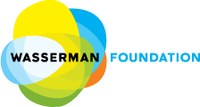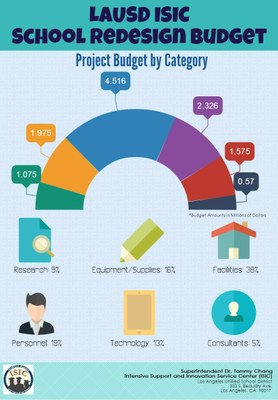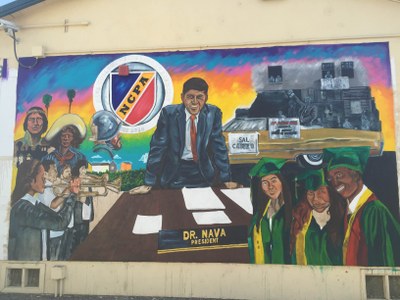Innovation Action Team-LAUSD-ISIC
Overview
“We believe that innovation fuels, supports, and accelerates all student learning; is the inspirational bridge that allows research-based and student-driven strategies to produce sustainable academic success for all and that innovation encompasses calculated risk taking and results must be shared with the larger community.”
 In applying to the Intensive Support and Innovation Center(ISIC), an Education Service Center in LAUSD, as a Common Core Math Expert, I was drawn to the idea of innovating in order to address some of the complex problems in LAUSD’s schools including issues of equity and access. Because schools are complex systems the old layers of reform and bureaucratic barriers have to be removed in order to pilot a new idea. One approach to innovating new solutions to complex problems is design thinking, an approach that is problem-focused, and used-centered with rapid learning based on piloting changes that move toward systemic solutions. In the summer of 2014 Entrepreneurs by Design trained a group of 20 of us from ISIC in design thinking. Later when given the chance at the beginning of the school year to be on an action team, I chose the Innovation Action Team lead by the superintendent of ISIC because I saw the potential of design thinking as an approach that innovates its way to improvement through a process that includes prototyping. Moreover through the superintendent’s own design of adult learning experiences during the innovation action team meetings and other leadership meetings I was exposed to blending learning techniques such as playlists within blogs and the idea of disruptive innovation. His initial vision for this work was to invite 2-3 schools to a process of complete redesign through design thinking. But first one school would redesign an aspect of their school such as the use of time and space, grading systems, curriculum, etc. Later through the superintendent’s connections to various foundations this vision grew to completely redesigning and transforming 10 schools, which could involve existing schools or, based on my feedback and others, it could also include creating new schools using the LAUSD pilot autonomy model.
In applying to the Intensive Support and Innovation Center(ISIC), an Education Service Center in LAUSD, as a Common Core Math Expert, I was drawn to the idea of innovating in order to address some of the complex problems in LAUSD’s schools including issues of equity and access. Because schools are complex systems the old layers of reform and bureaucratic barriers have to be removed in order to pilot a new idea. One approach to innovating new solutions to complex problems is design thinking, an approach that is problem-focused, and used-centered with rapid learning based on piloting changes that move toward systemic solutions. In the summer of 2014 Entrepreneurs by Design trained a group of 20 of us from ISIC in design thinking. Later when given the chance at the beginning of the school year to be on an action team, I chose the Innovation Action Team lead by the superintendent of ISIC because I saw the potential of design thinking as an approach that innovates its way to improvement through a process that includes prototyping. Moreover through the superintendent’s own design of adult learning experiences during the innovation action team meetings and other leadership meetings I was exposed to blending learning techniques such as playlists within blogs and the idea of disruptive innovation. His initial vision for this work was to invite 2-3 schools to a process of complete redesign through design thinking. But first one school would redesign an aspect of their school such as the use of time and space, grading systems, curriculum, etc. Later through the superintendent’s connections to various foundations this vision grew to completely redesigning and transforming 10 schools, which could involve existing schools or, based on my feedback and others, it could also include creating new schools using the LAUSD pilot autonomy model.

I worked as part of a small team on creating a budget proposal for the 10 school redesign plan through first year of implementation for a presentation to the Wasserman Foundation. Moreover I also helped to design an application process for schools interested in participating in a school re-make challenge which was funded by the Gates Foundation.
The innovation action team’s momentum and existence largely lost steam by the end of the first semester due to a lack of funding and a change in leadership and so the vision of this particular action team was not fulfilled; however it did impact several schools.
Budget Proposal to Wasserman Foundation
 I took initiative to make this work of redesigning school as a personal priority and was rewarded by the superintendent of ISIC with an opportunity to create a budget proposal to fund the creation of 10 design teams who would create innovation plans for 10 schools to be transformed through design thinking. Initially I sought to create a modified spreadsheet I had used to keep track of expenses on a quarterly basis for grants I had won as part of school teams of $30,000 and $15, 000. Initially I was tasked with developing a budget proposal for 8-10 teachers from 3 schools and 10 people from ISIC for research trips to other innovative schools in California as well as designing thinking training sessions over Winter and Spring Breaks. Soon thereafter though an opportunity came along to pitch a more expansive vision for design thinking to be employed in redesigning 10 schools over the course of two school years.
I took initiative to make this work of redesigning school as a personal priority and was rewarded by the superintendent of ISIC with an opportunity to create a budget proposal to fund the creation of 10 design teams who would create innovation plans for 10 schools to be transformed through design thinking. Initially I sought to create a modified spreadsheet I had used to keep track of expenses on a quarterly basis for grants I had won as part of school teams of $30,000 and $15, 000. Initially I was tasked with developing a budget proposal for 8-10 teachers from 3 schools and 10 people from ISIC for research trips to other innovative schools in California as well as designing thinking training sessions over Winter and Spring Breaks. Soon thereafter though an opportunity came along to pitch a more expansive vision for design thinking to be employed in redesigning 10 schools over the course of two school years.
 Based on my own limited experience with budgeting for relatively small amounts for 4-5 people in spending grant money for small school improvement projects related to teaching and learning at one school site, I knew that I needed additional help and so two other innovation action team members soon joined me. We met as a team of three twice and during that time we brainstormed and created a project budget proposal and project timeline. The final project budget proposal totaled a little over $12 million dollars, based on encouragement to think big from LAUSD’s former superintendent, and it covered expenses in the categories of research, equipment/supplies, facilities, personnel, technology, and consultants. The project timeline for getting the foundational work and implementation of the ISIC’s School Redesign Project for these ten schools covered the two full school years, two summers, and the fall semester of a third school year. One of the team members also created an infographic of the budget to make the categories more visual for those in attendance at the Wasserman-LAUSD meeting.
Based on my own limited experience with budgeting for relatively small amounts for 4-5 people in spending grant money for small school improvement projects related to teaching and learning at one school site, I knew that I needed additional help and so two other innovation action team members soon joined me. We met as a team of three twice and during that time we brainstormed and created a project budget proposal and project timeline. The final project budget proposal totaled a little over $12 million dollars, based on encouragement to think big from LAUSD’s former superintendent, and it covered expenses in the categories of research, equipment/supplies, facilities, personnel, technology, and consultants. The project timeline for getting the foundational work and implementation of the ISIC’s School Redesign Project for these ten schools covered the two full school years, two summers, and the fall semester of a third school year. One of the team members also created an infographic of the budget to make the categories more visual for those in attendance at the Wasserman-LAUSD meeting.
The outcome of the project proposal pitch for funding to the Wasserman Foundation was that our proposal was not provided any funding. In part this was due to the fact that the Wasserman Foundation had different ideas for a partnership with ISIC. However the Gates Foundation provided funding for a school remake challenge embracing the use of design thinking to remake one aspect of a school. I joined a small team in designing an application process for schools in ISIC interested in being remade in some way.
Designing the Application Process for the “School Re-Make Challenge”
 Because of a lack of funding the vision was reduced back down to redesigning one aspect of a 2-3 schools. Thus as part of a small team I was tasked with designing an application for school interested in school remake challenge over two days and led by a design thinking consultant from Stanford University. We met one day and designed an application flyer for schools to host and participate in a design thinking challenge to create an innovation plan to remake an aspect of their school. The school that won the challenge would have their plan funded by the Gates Foundation. We engaged with design thinking in the process of brainstorming and one of our team members then put our ideas together into a flyer using a graphic design program. The flyer described the challenge and provided information about the format of the application and the deadline for submitting applications.
Because of a lack of funding the vision was reduced back down to redesigning one aspect of a 2-3 schools. Thus as part of a small team I was tasked with designing an application for school interested in school remake challenge over two days and led by a design thinking consultant from Stanford University. We met one day and designed an application flyer for schools to host and participate in a design thinking challenge to create an innovation plan to remake an aspect of their school. The school that won the challenge would have their plan funded by the Gates Foundation. We engaged with design thinking in the process of brainstorming and one of our team members then put our ideas together into a flyer using a graphic design program. The flyer described the challenge and provided information about the format of the application and the deadline for submitting applications.
Based on the needs of the design thinking consultant and time constraints our flyer was not used and Google Form was sent out instead to schools that were already ‘innovative’ in some way. The school remake challenge itself took place about a month later and the school that won the challenge had several murals painted on school buildings to represent the name and vision of the school in creating a college going culture.
CAPEs Connections
CAPE 10- Implementing Change Strategies Based on Current, Relevant Theories and Best Practice in School Improvement.
Employing design thinking is an approach to school improvement that holds promise for addressing tough challenges in urban schools no matter the problem because of a focus on listening to end users to see problems from their perspective and then to design and revise a series of prototypes based on their feedback. It is not a top-down approach and is very much focused on meeting the needs of teachers if employed by school leaders or the needs of students if employed by teachers. A relationship is formed by the exchange of feedback on designs and the result is a solution to problems that includes the voice and ideas of those carrying out the work. Thus this project connects to and addresses several aspects of CAPE 10.
CAPE 11- Identifying and Using Available, Human, Fiscal, and Material Resources to Implement the School Growth Plan
This project focused on identifying additional fiscal resources through the Wasserman and Gates Foundation to carry out the vision. Moreover it meant leveraging human resources such as the design thinking consultant and the innovation action team to put together project proposals, design an application process for schools to learn about design thinking and apply design thinking in redesigning an aspect of their school, and in planning the event itself. A school leader would need to be able to create budgets as part of proposals or applications for grants such as the i3 grant and then implement and monitor those funds. Of course doing so could lead to more fiscal resources to the existing school budget resources, which could in turn lead to more human and material resources. Thus this project connects to and addresses several aspects of CAPE 11.
CAPE 17-Developing, Implementing, and Monitoring the School’s Budget
Although not a school budget, a project budget proposal was created through a process that included multiple perspectives and it included multiple categories and was spread out over two years in alignment with a project timeline. Google spreadsheets was used to collaborate together as a team in creating the budget and eventually a polished Microsoft Excel spreadsheet was created as well as an infographic. This project included many of the skills a principal would need to have to develop, implement, and monitor the school’s budget. Thus this project connects to and addresses several aspects of CAPE 17.
Reflection
My role in relation to both activities was as a team member with an equal voice working together to support the use of design thinking in schools towards the goal of improving some aspect of the school with a limited amount of resources. The long-term goal was about innovating and improving to provide a high quality education for all students.
A challenge for me was having the time to meet with the other members of each team in person in part because my main role is supporting schools with professional development while the other team members worked at the LAUSD headquarters building and could focus on the work of the innovation action team. The challenges for the group included having the scope of the vision be reduced due to our  proposal not being accepted by the Wasserman Foundation and eventually a complete stoppage of the work of the innovation action team due to a change in leadership at the very top of the hierarchy in LAUSD.
proposal not being accepted by the Wasserman Foundation and eventually a complete stoppage of the work of the innovation action team due to a change in leadership at the very top of the hierarchy in LAUSD.
The biggest success was having a school beautified through murals that represented the namesake and the vision of a brand new pilot high school in ISIC. In visiting the school later and it talking to the principal, teachers, and some students you could see in an tangible way how the daily reminder of seeing various prestigious private and public university logos painted on the school buildings can contribute to an expectation that all students will attend college.
Supporting Documents

